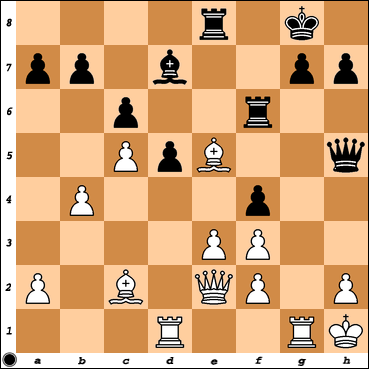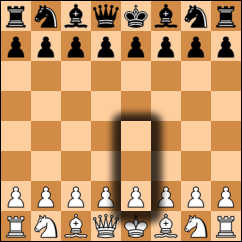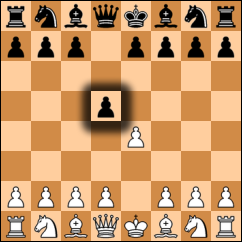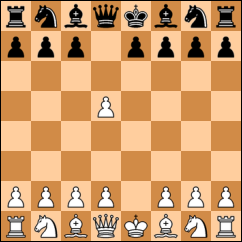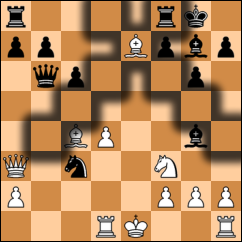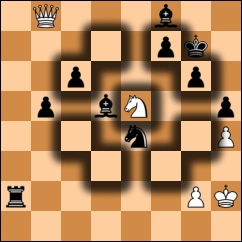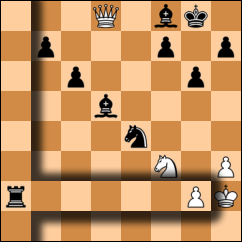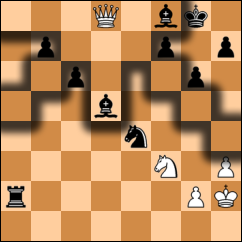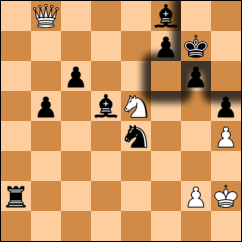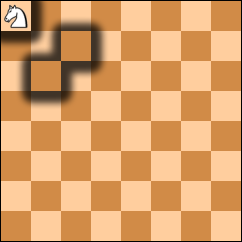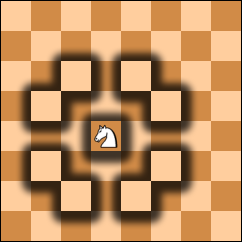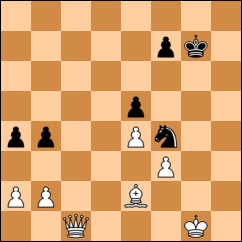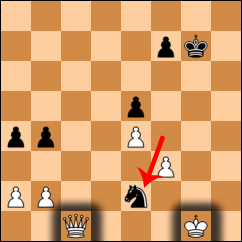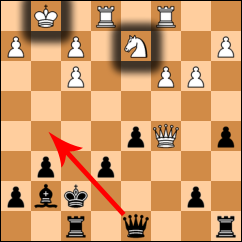The Bishop, in contrast, can move as far as it wishes along the diagonals. And for the nits out there, no, it cannot move through pieces.
The knight is tricky. Its move looks like an 'L'. The knight moves two squares in any direction and then one square to the left or right. A diagram will make this more clear:
Another note for the nits out there: the knight can hop over pieces, because as everyone knows, knights were known as the jumping warriors of the Middle Ages.
The rook is easy. Rooks move as far as they want horizontally or vertically. Like the Bishop, they cannot jump over pieces.
The queen is a combination of rook and bishop. She can move as far as she wishes diagonally, horizontally, or vertically.
The king is like a hobbled queen. He can move in any direction, but only one square at a time. Of course the king can also castle, but we'll get to that later.
The rules of chess
Chess is more straightforward than people realize. Two sides, white and black, try to checkmate each other. Play starts with the white player and the players take turns moving one piece at a time until the game ends. The only exception is castling, when a player can move two pieces in one turn...we'll be discussing that shortly.
The game can end in a draw or a victory:
A player wins when either the opponent concedes or the enemy king is checkmated. Checkmate is when the enemy king is in check (attacked by an enemy piece) and the king cannot escape. The king can escape check by moving to a square not controlled by an enemy piece, by capturing the checking piece, or by blocking the check with a friendly piece. It is important to note that it is illegal for the king to move into check.
The game can end in a draw several different ways, but the two most common ways are for the players to either decide that neither side can win and agree to a draw or for the game to end in stalemate. Stalemate is when one side cannot make any legal moves.
To summarize: Try to checkmate the enemy king, move the pieces how they're supposed to, and don't move into check.
Now for some of the weird rules:
Castling: This is the only time when two pieces can move in a single turn. Castling is done with the king and rook, and is used to evacuate the king from the center. The king can castle with either rook. To castle, the king moves two squares (!) in the direction he wishes to castle, and the rook is placed on the other side. Now there are a few important restrictions. There can't be any pieces between the king and rook. Additionally, neither the king nor rook can have moved previously. And finally, the king cannot castle through check.
Pawn Promotion: When a pawn reaches the other side of the board, it can "promote" and become any other piece. Players generally promote to the best piece, the queen. Polygamy is allowed. I don't understand how all of this fits into the chess as war metaphor, but it's a good thing when you can promote your pawns.
En Passant: This one sounds like it has to be made up. It's not even in English. That's right, en passant is French, the language of love and obscure chess rules. Meaning "in passing," en passant is used when you have a pawn on the fifth rank (three squares ahead of its starting point) and an enemy pawn tries to move two squares past your pawn. Using en passant you are actually allowed to capture the cowardly pawn.
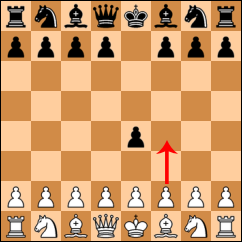
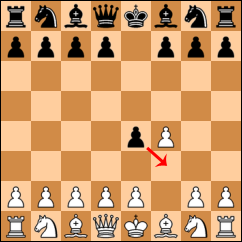
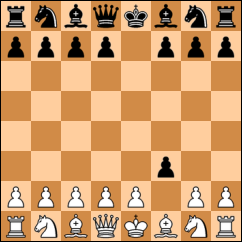
That does it for the rules you absolutely need to play. There are more obscure rules, like the 50 move rule, the insufficient mating material rule, and the infamous "infield fly" rule, but they aren't that important for someone just starting out in chess. Nobody likes a rules lawyer anyways.
Now some basic ideas behind the game!!!
Let's start with the famous quote
"Checkers is for tramps" - Paul Morphy
If you're a thrill seeker with a paranoid streak, chess may be the game for you. After all, a 2002 study concluded that "unconventional thinking and paranoia" characterize competitive chess players, two attributes the study also noted as characteristic of thrill-seekers like daredevils and skydivers. So remove the tinfoil hat and put away the bungee cord, because it's time to learn how to play chess.
Playing a decent game of chess is easy, once you have some basic knowledge:
1. Know how the pieces move and the rules
I'm going to assume you know these. But do not stop reading just because you've forgotten how the horsey moves, or you don't know what Castling, Pawn Promotion or En Passant are.
2. Know the values of the pieces
You can't play chess unless you know how much your pieces are worth. Once you do, you'll know when to exchange pieces and when to retreat. With the exception of the king, whose life is priceless, all the pieces have a point value. Although these values can change slightly depending on specific circumstances, they're usually accurate. The basis for the value of the other pieces is the pawn, valued at one point. Next come the knight and bishop. In some positions the bishop thrives while in others the knight dominates, but overall, they're worth about three points each. The rook is slightly more valuable, at five points. Finally we have the best piece of all, the queen. She's worth 9 points. Her sentimental value to the king is negligible (win or lose, she always comes back to him).
So we've got pawn = 1, bishop/knight = 3, rook = 5, queen = 9
Whenever you're considering trading pieces, know the values. Don't give up a rook for a bishop or knight. But, if you can get a bishop and two pawns for a rook that's fine ( bishop (3) + two pawns (2) = rook (5)). It's even slightly better since quantity of pieces is a good tiebreaker.
Note: The next three points are general chess principles that all players need to remember.
3. Play to control the center
This is a big one. The "center" refers to the four center squares on a chess-board.
Almost everything that happens on the board will involve traveling through one of these four squares. A player with uncontested control of the center has a huge advantage. You can either occupy this region with pawns or attack it with pieces...it doesn't matter as long as you've got something going on in the middle of the board. To illustrate the importance of the center, compare a knight in the middle of the board with one in the corner. The knight in the corner can only move to two squares, while the one in the center can move to eight.
4. Develop your pieces
You can't win a game of chess without bringing out your pieces. I often see beginning players develop their most powerful piece, the queen, and shuffle it around, hoping to capture wayward enemy pieces. This is like playing football with only the quarterback...boneheaded. Mobilize your pieces rapidly, especially the bishops and knights. Since they can maneuver through cluttered positions, they function especially well early in the game.
5. Protect the king
This one should be obvious. The game ends if you're checkmated. But how do you protect the king? Well it's easy. Castle. Since everything goes through the center, a king in the center of the board won't survive long. Tuck him away in the corner. Leave the fighting to his better half.
Note: the more of these three rules of thumb you can follow during the opening, the better. Don't play moves that only control the center or blindly develop your pieces. Try to do both at the same time. Even better, control the center, develop your pieces, and protect the king all at once.
6. Take Pieces
Every move, check to see if you can capture any opposing pieces. If you can, consider the point values and choose a course of action. Most people play chess like boobs-they'll put their pieces unprotected where you can take them.
7. Look for Double Attacks
Better players won't just throw their pieces away. You'll have to win them. That's where double attacks come in. Since a player is only allowed to move one piece at a time, meeting two simultaneous threats is very difficult. For this reason, making two threats at once, also known as executing a double attack, constitutes the most basic tactical idea. To illustrate the double attack's power, we'll examine the knight fork:
Additionally, double attacks usually revolve around undefended enemy pieces. If you can spot two undefended pieces and attack them at once, you're guaranteed to win one. So when you're considering where to move, watch for undefended pieces.
8. Watch for Checks
Before moving, look to see if your opponent has potential checks. Since a check is the most forcing move, it can lead to heaps of trouble. If you spot a possible check, make sure it doesn't create a double attack (like checking your king and attacking an undefended piece at the same time) or lead to other trouble.
Conclusion
If you follow these guidelines, you'll be able to play a decent game of chess. Congratulations, you've just taken the first step on the road to paranoia, misanthropy, and madness.
 If you liked the article kindly Digg it, Stumble it, Add to Technorati, bookmark it and please consider subscribing through "Subscribe by Email" and have articles & a Everyman Chessbase eBook delivered right to your inbox! OR "Subscribe to Chess Blog Feed" in a Fead Reader of your choice OR Subscribe to "SMS Alerts" & Get Article Headlines & Updates delivered to your Mobile Phone for free.
If you liked the article kindly Digg it, Stumble it, Add to Technorati, bookmark it and please consider subscribing through "Subscribe by Email" and have articles & a Everyman Chessbase eBook delivered right to your inbox! OR "Subscribe to Chess Blog Feed" in a Fead Reader of your choice OR Subscribe to "SMS Alerts" & Get Article Headlines & Updates delivered to your Mobile Phone for free.










